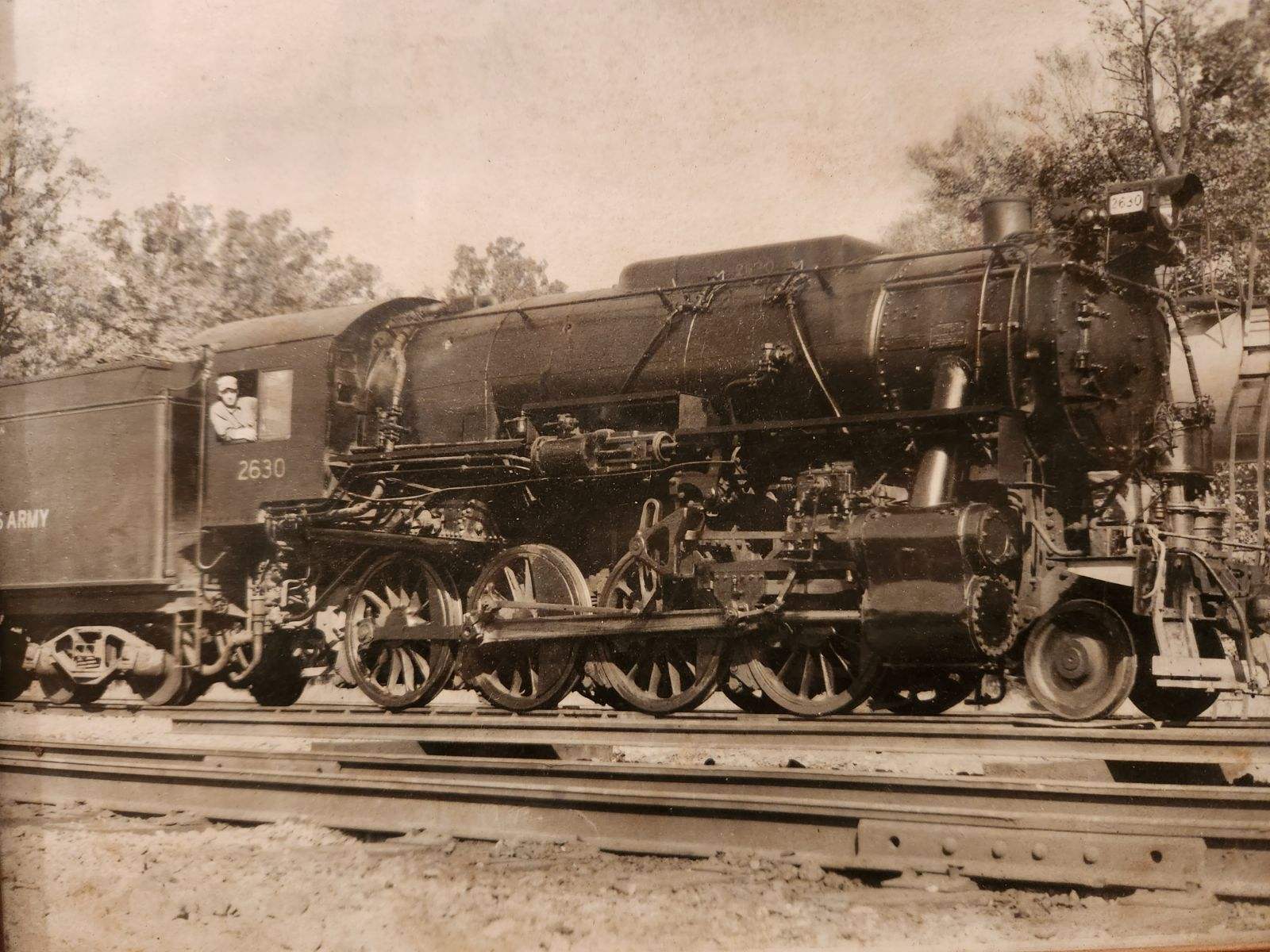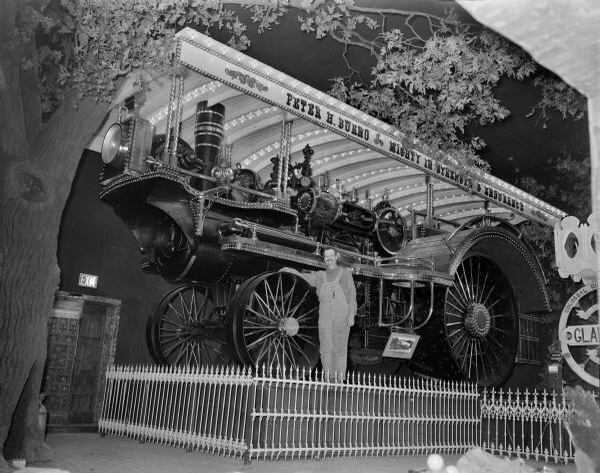Peter Burno, owner of the Burno Boiler and Engine Works
Are you interested in Hydro-Power, Steam Engines,
Locomotives, Engineering, Stoughton History, or just want to read an
interesting story of a man who lives in Stoughton? If so, you will be interested to read about
Peter Bruno.
Photos from the Stoughton Courier Hub, August 2, 1979
As seen in the photos above he
operated the Fourth Street Dam in Stoughton
Mr. Burno is the
owner of The Burno Boiler and Engine Works, successors to Harrison Machine
Works and manufacturers of Steam Traction Engines, Corliss and Slide Valve
Engines, Saw Mills, Boilers and Mill Machinery of all kinds. Burno Boiler & Engine Works was
established by his great uncle in 1848 and was the oldest continually operating
producer of steam-driven machinery in Wisconsin. Peter is now 93 years old.
The following
excerpts are taken from Peter’s autobiographical "My Life, My Story”
“My mother always
thought I should be a doctor. I never
would have been a good doctor. From the
time I was three, I wanted to be an engineer – I wanted to work with steam
engines. I just loved machines. And while I never had the opportunity to go
to college, I ended up learning from some masters.
My grandfather
was an engineer on the Rock Island Railroad and then designed the biggest
pumping engine anyone had ever built for the city of Chicago.” “When I was four, (my father) took me to meet
Samuel Insull, at Customer Hall in Chicago.
Insull had been Thomas Edison’s secretary and troubleshooter. He was the one who put all the various Edison
companies together to create GE, and at that point was president of
Commonwealth Edison.”
“I got my first
job when I was 12, an apprentice at Rickeby Forge, a blacksmith and wagon maker. It was run by a Dutchman, Peter Van
Brussel. He looked me in the eye and
said, ‘I’ll feed you if you work hard for me.’
Money was never mentioned, and I never got a penny. I got two sets of clothes a year – not new
ones. I could continue going to school,
but I had to have the shop swept out and the fires built in the forges before I
left. We worked till dark every night,
seven days a week, and I slept in the shop.”
“I worked at the
forge for three years, till I was fifteen.
Then I went up to Michigan to work for the Mayhew Lumber Company for the
summer. I went as a cook’s helper, but
when they found out I was a journeyman blacksmith, they put me in the
shop. So I learned to shoe oxen. I’d shoed horses before but never an ox. It’s hard.
Oxen are low and have a cloven hoof, so each animal needs eight
shoes. Mayhew had steam donkey engines
for lifting logs and pulling them up slopes, so I learned about steam engines
from some masters, which stood me in good stead later on. I thought I had the world by the tail. I thought, I’m eating regularly, and I’m
learning things. How lucky I am.
At the end of
summer, I started attending private school.
I earned my way by firing the boilers.”
“I started looking for work on the railroads when I was sixteen . . . In
those days you had to fire for four years before you could take the engineer’s
examination. All the engineers and firemen
were old men, so I could see it was a good opportunity. I fired for four years, studying the whole
time – I’ve been a bookworm all my life and easily passed the exam. Everybody retired at once, and I became an
engineer. Then I went on to take some further
exams.”
“Then, in 1951, I
got drafted. At first, the Army couldn’t
believe that anyone that young was a qualified locomotive engineer. I had to get the paperwork to prove it. This was when the government was still
pulling its own troop trains. The Army
would lease locomotives and trackage rights from civilian railroads, and they
needed civilian-qualified engineers to operate the trains. There were only two of
us draftees in the entire Army who were qualified, and because I’d taken the additional
exams, I was their top engineer. The
locomotives they leased were always the biggest and best, whether it fit the
situation or not. I’ve run locomotives
that are just history today. I ran the
Big Boy. I ran everything the Chesapeake
& Ohio had, and just about everything the Norfolk & Western had.
After a year, the
Army gave up the idea of pulling its own troop trains in the U.S., but they
still had locomotives operating overseas and on Army posts. So, at age 22 I ended up running the biggest
locomotive repair shop owned by the federal government.” To read more about his interesting military
locomotive repair work
click here.

Photo used with permission, Peter in the Army
“In the 1970s, I started
designing dams and hydro plants. We have
designed fourteen power plants from scratch to date. In addition, we have designed and built in
our own shops switchboards, hydraulic turbines, and shafting and associated
machinery. We have also designed and
made our own windings for customers’ generators, furnished overhead cranes, and
machined and finished shafting for several of these plants.”
“I eventually
bought three hydroelectric plants of my own and formed the Wisconsin Edison
Corporation, which operated from 1972 ‘til 2007.”
“I joined the
American Military Engineers in 1959 and later became a life member. In 1955, I helped found the Rock River
Thresheree.”
Above Excerpts
taken from Peter’s written My Life, My Story
Peter Burno has
achieved many professional credentials.
His list is long, below are a few:
· President and co-founder of Rock River
Steam Thresheree Association, Inc., Edgerson, Wisconsin
· Consultant for Equipment Placement and
Erection, Power Plant No. 3, Grand Coulee Dam
· Designing Engineer, Power Plants in
Vermont, Wisconsin, Indiana, Illinois, and Idaho
· Mechanical Appraisals and Consultation
for the National Railway Museum at Green Bay, Wisconsin, including Locomotives,
Rolling Stock, Cranes, Bridges and Right-of-Way
· Consulting Engineer for House on the
Rock, Dodgeville, Wisconsin
· President, Wisconsin State Association
of Power Engineers, Inc.
· Chairman, Power Committee, United
States Standards Institute
· Co-author, National Power Engineering
Standards
· Chief Technical Editor, National
Engineer Magazine
· Life Member, Society of American
Military Engineers
· Founder, Wisconsin State
Apprenticeship Program for Power Engineers
· Chief Engineer, Wisconsin Edison
Corporation
· Co-founder, Incorporator, Wisconsin
Historical Steam Engine Owners Association
· Member, Design Team, Baldwin
Locomotive Works, Last Standard-Gauge Steam Locomotive Built for Service in United States

Photo above was provided to the Wisconsin Historical Society
by Friends of Sid Boyum. Wisconsin Historical Society WHI- 122040
Peter Burno
posing with the steam locomotive he built which is on display behind a fence at
House on the Rock. The sign above the train reads: "Peter H. Burno. Mighty
in Strength & Endurance." There is a large, fake tree on the left.
If you missed the WSTO interview with Peter Burno, check the WSTO schedule for a possible replay.